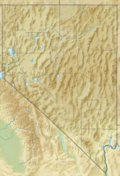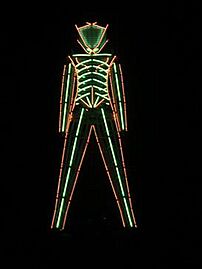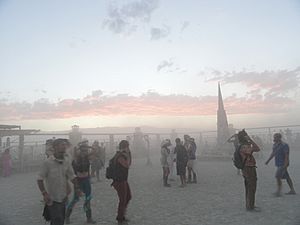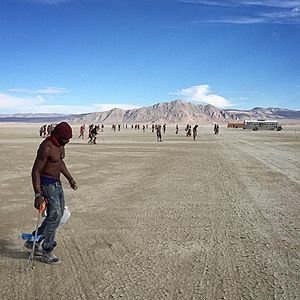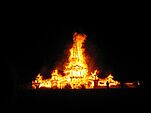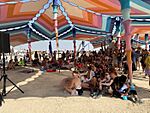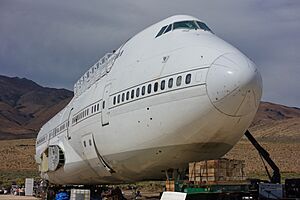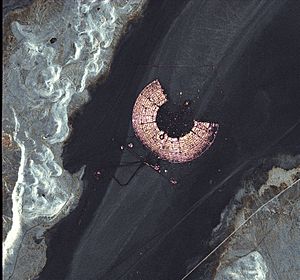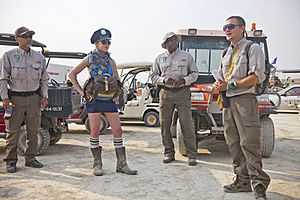Burning Man facts for kids
Quick facts for kids Burning Man |
|
|---|---|
 |
|

The Temple, Burning Man 2016
|
|
| Begins | August 31, 2025 |
| Ends | September 1, 2025 |
| Venue | Black Rock City |
| Location(s) | Black Rock Desert, Pershing County, Nevada, US |
| Coordinates | 40°47′13.088″N 119°12′14.764″W / 40.78696889°N 119.20410111°W |
| Years active | 39 |
| Inaugurated | June 22, 1986 |
| Founders | Cacophony Society Larry Harvey John Law Jerry James |
| Participants | 2019 (official): 78,850 2021 (unofficial): 20,000 |
| Organised by | Burning Man Project |
Burning Man is a special week-long event held every year in the western United States. It focuses on ideas like community, art, being yourself, and being able to take care of yourself. The event gets its name from its main ceremony: burning a huge wooden statue, called the Man. This happens on the Saturday night before Labor Day.
Since 1990, Burning Man has taken place in a temporary city called Black Rock City. This city is built in the Black Rock Desert in northwestern Nevada. It's about 100 miles (160 km) north-northeast of Reno.
Larry Harvey, one of the people who started Burning Man, said in 2004 that the event follows ten important ideas. These are: radical inclusion, gifting, decommodification, radical self-reliance, radical self-expression, communal effort, civic responsibility, leaving no trace, participation, and immediacy.
Burning Man doesn't have famous performers or a set schedule. Instead, everyone who attends creates the art, activities, and events. The artwork includes cool and interactive sculptures, buildings, shows, and art cars. These creations are inspired by a different theme chosen each year by the Burning Man Project.
Some people call Burning Man a "countercultural revelry," which means it's a fun, rebellious gathering. Its organizers describe it as an "excuse to party in the desert." However, in 2019, NPR noted that it has become a popular spot for social media stars, celebrities, and people from Silicon Valley.
Burning Man started small on June 22, 1986, at Baker Beach in San Francisco. Larry Harvey and Jerry James built the first Man. Since then, it has happened every year for nine days, ending on Labor Day. More and more people have joined over the years. In 2019, about 78,850 people took part.
The Burning Man Project organizes the event. This is a nonprofit group that took over from a for-profit company in 2013. The Burning Man Project also supports smaller events around the world. These events follow the same Burning Man principles.
The film Stalker by Tarkovsky greatly influenced the Cacophony Society. This group started in 1986 in the San Francisco Bay Area and organized special "Zone Trips." The first time a wooden man was burned in the Black Rock Desert, Nevada, was during "Zone Trip Number 4" in 1990. This event then grew into the huge annual festival we know today.
Contents
- History of Burning Man
- Burning Man Over the Years
- Burning Man's 10 Principles
- The Temple at Burning Man
- Art at Burning Man
- Mutant Vehicles
- Bicycles
- Theme Camps
- Black Rock City Layout
- Black Rock City Design Changes
- Getting to Burning Man
- "Leave No Trace" Policy
- Environmental Efforts
- Regional Events
- Films About Burning Man
- See also
History of Burning Man
How Burning Man Started
Burning Man began as a bonfire celebration on the summer solstice. Before 1986, Mary Grauberger, a friend of Larry Harvey's girlfriend, held these solstice bonfires. Larry Harvey sometimes went to them. When Mary stopped, Larry decided to continue the tradition.
On June 21, 1986, Larry and Jerry James built the first wooden statue. It was made from old wood and was 8 feet (2.4 meters) tall. On June 22, they and a few friends burned it, along with a smaller wooden dog, on Baker Beach in San Francisco. Larry Harvey later said he burned them as a way to "radically express himself." In 1987, the Man grew to 15 feet (4.6 meters) tall, and by 1988, it was 30 feet (9.1 meters) tall.
In 1988, Larry Harvey officially named the summer solstice event "Burning Man." He did this to avoid confusion with "wicker man" stories, which are old Celtic pagan practices. Harvey said he hadn't even seen the 1973 movie The Wicker Man until much later.
Moving to the Desert
In 1990, Kevin Evans and John Law planned a separate event. It was to be held in the remote Black Rock Desert, about 110 miles (177 km) north of Reno, Nevada. Evans imagined it as a temporary art zone where sculptures would be burned. He asked John Law, who knew the desert well and helped start the Cacophony Society, to help organize it. They called it Zone Trip No. 4.
Meanwhile, the summer solstice burn at Baker Beach was stopped by park police because they didn't have a permit. The Man was taken apart. Soon after, parts of the Man were cut up and removed because the space was rented for parking. But the Man was rebuilt in time to be taken to Zone Trip No. 4 in the desert.
Michael Mikel, another person from the Cacophony Society, realized people might get lost in the desert. He created the Black Rock Rangers to help guide participants and keep them safe. This is how Black Rock City started, with ideas from Evans, Grauberger, Harvey, and James. In 1991, John Law added neon lights to the Man. This made it glow at night and helped people find their way.
In the early years, the event grew by word of mouth. Everyone was seen as a participant who added to the creative atmosphere. There were no paid performers or strict rules, just "Don't bother anyone else's experience."
In 1991, the event got its first legal permit from the BLM (Bureau of Land Management). In 1992, amplified music appeared for the first time. Craig Ellenwood and TerboTed set up the first EDM camp. In 1993, "Christmas Camp" became the first theme camp, giving out fruitcake and eggnog.
By 1996, the event had grown to 8,000 people. It was the last year the event was held in the middle of the desert without a fence. After 1996, John Law left the Burning Man organization.
Changes and Growth (1997-2019)
In 1997, Burning Man had to move because another event had a permit for the Black Rock Desert. It moved to Hualapai Flat, which meant it was under the rules of Washoe County. This brought many new permit requirements.
To meet these new rules and manage the growing event, Larry Harvey and five other organizers formed Black Rock City LLC in 1999. They created the Black Rock City Department of Public Works (DPW) to build the city's grid layout. This grid was needed so emergency vehicles could find their way. Rod Garrett designed the city layout and continued to do so until he passed away in 2011.
In 1998, Burning Man returned to the Black Rock Desert, but closer to Gerlach, and with a temporary fence. It has stayed there ever since. As Black Rock City grew, the BLM added more rules. Tickets started to be sold online to everyone. Some people felt these rules took away from the original freedom, but many new attendees enjoyed the increased activities.
New rules included:
- A grid of streets to help with navigation.
- A speed limit of 5 mph (8 km/h).
- A ban on driving, except for special "mutant vehicles" and service vehicles.
- Safety rules for mutant vehicles.
- Art must be burned on a special platform to protect the desert.
- Fireworks and animals were banned.
A 9.2-mile (14.8 km) plastic fence, called the "trash fence," was added in 2002. It helps catch wind-blown trash. The area beyond this fence is not open to participants during the event.
Recent Years (2020-Present)
On April 10, 2020, the Burning Man Project announced that the event was canceled for 2020 because of the COVID-19 pandemic. This was the first time Burning Man didn't happen since it started. They even offered ticket refunds, even though tickets were usually non-refundable.
Despite the official cancellation, about 5,000 people still went to the Black Rock Desert for an unofficial event in 2020. Some said it felt like a return to the "old days." The 2021 event was also canceled due to the pandemic. However, an estimated 20,000 people showed up for another unofficial gathering. The Bureau of Land Management put in place rules like no large structures and only campfires. Instead of burning a Man statue, there was a huge illuminated drone display.
In 2023, heavy rains and flooding hit Burning Man during Labor Day weekend. This stopped vehicles from moving around the site. Organizers shared a "Wet Playa Survival Guide" and told people to save food, water, and fuel. One person died during the flooding, and thousands were stuck.
On August 25, 2024, a participant died on the first day of the festival. For the first time since 2011, tickets for the festival remained unsold. A large dust storm on the last day caused long delays for people leaving the event.
Burning Man Over the Years
This table shows how Burning Man has grown. It includes details like where it was held, the height of the Man statue, how many people attended, ticket prices, and the number of camps and art pieces.
The Man statue started at 8 feet (2.4 meters) tall. It grew taller each year until 1989, when it reached 40 feet (12 meters). It stayed at 40 feet until 2013. During those years, the base it stood on changed in size and shape. In 2014, the Man was built differently, standing 105 feet (32 meters) tall directly on the ground. From 2015 to 2019, the Man returned to 40 feet (12 meters) in height.
| Year | Location | Theme | Man height | Population | Bureau of Land Management population limit | Ticket price(s) | Weather Overview | Number of theme camps, mutant vehicles, and placed art |
|---|---|---|---|---|---|---|---|---|
| 1986 | Baker Beach | None | 8 ft (2.4 m) | 35 | Not on BLM land | Free | None | |
| Larry Harvey and Jerry James burn a wooden statue of a man at Baker Beach. | ||||||||
| 1987 | Baker Beach | None | 15 ft (4.6 m) | 80 | Not on BLM land | Free | None | |
| This year's Man was built from cut lumber over several weeks. | ||||||||
| 1988 | Baker Beach | None | 30 ft (9.1 m) | 200 | Not on BLM land | Free | None | |
| Larry Harvey officially names the event "Burning Man." | ||||||||
| 1989 | Baker Beach | None | 40 ft (12 m) | 300 | Not on BLM land | Free | None | |
| Burning Man is first mentioned in the San Francisco Cacophony Society newsletter. | ||||||||
| 1990 | Baker Beach & Black Rock Desert |
None | 40 ft (12 m) |
|
None | $15 (requested donation) | None | |
| The Man was set up at Baker Beach but not burned. It was then moved to the Black Rock Desert for a special trip. | ||||||||
| 1991 | Black Rock Desert | None | 40 ft (12 m) | 250 | None | $15 (requested donation) | None | |
| The Man was decorated with neon lighting for the first time. | ||||||||
| 1992 | Black Rock Desert | None | 40 ft (12 m) | 600 | None | $25 (requested donation) |
|
|
| amplified music first appeared at Burning Man. The first EDM camp was set up. | ||||||||
| 1993 | Black Rock Desert | None | 40 ft (12 m) | 1,000 | None | $40 |
|
|
| "Christmas Camp" becomes the first theme camp. | ||||||||
| 1994 | Black Rock Desert | None | 40 ft (12 m) | 2,000 | None | $30 |
|
|
| First year for wooden spires and lamp lighting. | ||||||||
| 1995 | Black Rock Desert | 40 ft (12 m) | 4,000 | None | $35 |
|
||
| The Center Camp Cafe started selling coffee. | ||||||||
| 1996 | Black Rock Desert | heLLCo | 48 ft (15 m) | 8,000 | None | $35 |
|
|
| The theme was a funny take on Dante's Inferno. The Man was placed on a straw bale pyramid. The event faced challenges with permits. | ||||||||
| 1997 | Hualapai Playa | Fertility | 50 ft (15 m) | 10,000 | Not on BLM land |
|
|
|
| Burning Man moved to a new location. The city had grid streets and a driving ban for the first time. | ||||||||
| 1998 | Black Rock Desert | Nebulous Entity | 52 ft (16 m) | 15,000 | None |
|
|
|
| Burning Man returned to the Black Rock Desert. Google created its first Doodle to celebrate. | ||||||||
| 1999 | Black Rock Desert | Wheel of Time | 54 ft (16 m) | 23,000 | None |
|
|
|
| The event was listed in the AAA's RV guide. | ||||||||
| 2000 | Black Rock Desert | The Body | 54 ft (16 m) | 25,400 | None |
|
|
|
| The Temple became a regular part of the event. | ||||||||
| 2001 | Black Rock Desert | Seven Ages | 70 ft (21 m) | 25,659 | None |
|
|
|
| The theme was based on Seven Ages of Man. | ||||||||
| 2002 | Black Rock Desert | The Floating World | 80 ft (24 m) | 28,979 | None |
|
|
|
| First year for an FAA approved airport. | ||||||||
| 2003 | Black Rock Desert | Beyond Belief | 79 ft (24 m) | 30,586 | None |
|
|
|
| Dogs were banned for the first time. | ||||||||
| 2004 | Black Rock Desert | The Vault of Heaven | 80 ft (24 m) | 35,664 | None |
|
|
|
| The streets were named after planets. | ||||||||
| 2005 | Black Rock Desert | Psyche | 72 ft (22 m) | 35,567 | None |
|
|
|
| The Man was on a "funhouse" maze. | ||||||||
| 2006 | Black Rock Desert | Hope and Fear | 72 ft (22 m) | 38,989 |
|
|
|
|
| The Man's arms moved based on participant votes. | ||||||||
| 2007 | Black Rock Desert | The Green Man | 72 ft (22 m) | 47,097 |
|
|
|
|
| The Man was rebuilt after an incident. | ||||||||
| 2008 | Black Rock Desert | American Dream | 90 ft (27 m) | 49,599 |
|
|
|
|
| Tickets were not sold at the gate for the first time. The city layout was made larger. | ||||||||
| 2009 | Black Rock Desert | Evolution | 75 ft (23 m) | 43,558 |
|
|
|
|
| The city layout returned to its 2007 size. Attendance dropped due to the financial crisis. | ||||||||
| 2010 | Black Rock Desert | Metropolis | 104 ft (32 m) | 51,525 |
|
|
|
|
| Attendance went over 50,000 for the first time. | ||||||||
| 2011 | Black Rock Desert | Rites of Passage | 90 ft (27 m) | 53,963 | 50,000 |
|
|
|
| Tickets sold out before the event for the first time. | ||||||||
| 2012 | Black Rock Desert | Fertility 2.0 | 85 ft (26 m) | 56,149 | 60,900 |
|
|
|
| A new ticket system was used due to high demand. | ||||||||
| 2013 | Black Rock Desert | Cargo Cult | 85 ft (26 m) | 69,613 | 68,000 |
|
|
|
| The theme was based on Cargo Cults. | ||||||||
| 2014 | Black Rock Desert | Caravansary | 105 ft (32 m) | 65,922 | 68,000 |
|
|
|
| Vehicles needed a special pass to enter Black Rock City. | ||||||||
| 2015 | Black Rock Desert | Carnival of Mirrors | 69 ft (21 m) | 67,564 | 70,000 |
|
Night temperatures were very cold. Strong winds. |
|
| The Man's base was on the ground for the first time in almost 10 years. | ||||||||
| 2016 | Black Rock Desert | Da Vinci's Workshop | 70 ft (21 m) | 67,290 | 70,000 |
|
|
|
| The Man was designed like Vitruvian Man. | ||||||||
| 2017 | Black Rock Desert | Radical Ritual | 105 ft (32 m) | 69,493 | 70,000 |
|
Theme Camps: 1395
Mutant Vehicles: unknown Placed art: 317 |
|
| A person died after running into the burning Man. | ||||||||
| 2018 | Black Rock Desert | I, Robot | 85 ft (26 m) | 70,248 | 70,000 |
|
Theme Camps: 1472
Mutant Vehicles: 618 Placed art: 383 |
|
| The event reached its population limit, and new people could only enter when others left. | ||||||||
| 2019 | Black Rock Desert | Metamorphoses | 61 ft (19 m) | 78,850 | 80,000 |
|
Theme camps: 1545
Mutant vehicles: 632 Placed art: 415 |
|
| The way "population" was counted changed to include staff and volunteers. | ||||||||
| 2020 | Black Rock Desert | The Multiverse | N/A | 5,000 | N/A | N/A | Unknown | |
| Burning Man was canceled due to the COVID-19 pandemic. About 5,000 people attended an unofficial event. | ||||||||
| 2021 | Black Rock Desert | The Great Unknown | drone display | 20,000 | N/A | N/A | Camps: 500+ | |
| The event was canceled again due to the pandemic. An estimated 20,000 people attended an unofficial event. | ||||||||
| 2022 | Black Rock Desert | Waking Dreams | Not yet public information | 75,069 | 87,000 |
|
High temperatures during the event. | Not yet public information |
| The 2022 event took place in person. | ||||||||
| 2023 | Black Rock Desert | Animalia | Not yet public information | Not yet public information | 87,000 |
|
Heavy rain and flooding occurred. | Not yet public information |
| The event experienced bad weather and flooding. One person died. | ||||||||
| 2024 | Black Rock Desert | Curiouser & Curiouser | 87,000 |
|
Mild rain and strong winds during setup. Burn week had warm days and cool nights. | |||
| Tickets were available without registration for the first time in years. One person died on the opening day. | ||||||||
Counting the Population
The number of people at Burning Man is counted because of a special permit from the BLM. This count helps make sure the event doesn't go over the allowed number of people. Not everyone at the event is included in this count. For example, government staff are usually not counted.
The BLM used to use the population count to figure out fees for the event. They also started to set limits on how many people could attend. This caused some disagreements, as the BLM wanted to limit the event's size.
In 2006, the permit said that the event's population could not grow by more than 6% from the highest number in a past year. In 2011, the fee system changed and was no longer based on daily population counts.
In 2012, the permit clarified who was counted as a "participant." This included all attendees, even volunteers. In 2014, volunteers were specifically not counted, and the limit only applied to "paid participants."
However, in 2019, the definition changed again. Now, "population" included staff and volunteers. This meant everyone was counted. The maximum population limit was increased to 80,000 to fit this change. In 2022, an extra rule was added: the total number of attendees for the whole event could not be more than 87,000.
Burning Man's 10 Principles
Burning Man doesn't have just one main goal because so many different people, called "Burners," attend. The event focuses on things like community, artwork, being silly, not using money, and having fun. Everyone is encouraged to take part.
The Burning Man event and its related communities follow 10 principles. These ideas show the spirit that has grown from the event. Larry Harvey wrote them in 2004 to guide regional events, and they later became important for the whole Burning Man culture.
The 10 Principles are:
- Radical inclusion
- Gifting
- Decommodification
- Radical self-reliance
- Radical self-expression
- Communal effort
- Civic responsibility
- Leaving no trace
- Participation
- Immediacy
Here's what each principle means:
Radical Inclusion
"Anyone may be a part of Burning Man. We welcome and respect the stranger. No prerequisites exist for participation in our community." This means everyone is welcome to join the Burning Man culture. To attend the event, participants need to take care of their own basic needs, follow the event's "survival guide," and buy a ticket.
Gifting
"Burning Man is devoted to acts of gift-giving. The value of a gift is unconditional. Gifting does not contemplate a return or an exchange for something of equal value." Instead of using cash, Burners are encouraged to give gifts without expecting anything back. In the early days, people sometimes traded favors, but now, unconditional gifting is encouraged.
Decommodification
"To preserve the spirit of gifting, our community seeks to create social environments that are unmediated by commercial sponsorships, transactions, or advertising. We stand ready to protect our culture from such exploitation. We resist the substitution of consumption for participatory experience." This means no cash transactions are allowed between Burners. Cash can only be used for a few things like:
- Ice sales, which help local schools.
- Tickets for a shuttle bus to nearby towns.
- A wristband if you want to leave and re-enter the event.
- A fee to use the airport.
- Diesel fuel.
- RV waste disposal services.
- Private portable toilets.
Radical Self-Reliance
"Burning Man encourages the individual to discover, exercise, and rely on his or her inner resources." The desert environment and remote location mean participants must bring all their own supplies. Since most buying and selling is not allowed, you need to be prepared. Public portable toilets are available throughout the city.
Radical Self-Expression
"Radical self-expression arises from the unique gifts of the individual. No one other than the individual or a collaborating group can determine its content. It is offered as a gift to others. In this spirit, the giver should respect the rights and liberties of the recipient." Burners are encouraged to express themselves through various art forms and projects.
Communal Effort
"Our community values creative cooperation and collaboration. We strive to produce, promote and protect social networks, public spaces, works of art, and methods of communication that support such interaction." Burners are encouraged to work together and help each other.
Civic Responsibility
"We value civil society. Community members who organize events should assume responsibility for public welfare and endeavor to communicate civic responsibilities to participants. They must also assume responsibility for conducting events in accordance with local, state and federal laws." This means organizers and participants should act responsibly and follow laws.
Leave No Trace
"Our community respects the environment. We are committed to leaving no physical trace of our activities wherever we gather. We clean up after ourselves and endeavor, whenever possible, to leave such places in a better state than when we found them." This means participants must clean up everything and leave the desert exactly as they found it.
Participation
"Our community is committed to a radically participatory ethic. We believe that transformative change, whether in the individual or in society, can occur only through the medium of deeply personal participation. We achieve being through doing. Everyone is invited to work. Everyone is invited to play. We make the world real through actions that open the heart." People are encouraged to join in and create, rather than just watch.
Immediacy
"Immediate experience is, in many ways, the most important touchstone of value in our culture. We seek to overcome barriers that stand between us and a recognition of our inner selves, the reality of those around us, participation in society, and contact with a natural world exceeding human powers. No idea can substitute for this experience." This means living in the moment and experiencing things directly is very important.
The Temple at Burning Man
The Temple is another very important art piece at Burning Man, almost as important as the Man itself. It's a shared space for the community. It's not a religious building, but a neutral, spiritual place where people can think about the past, present, and future.
People can leave messages and objects inside the Temple to be burned. It's a place for quiet thought, rest, and even special events like weddings. About 400 volunteer Temple Guardians watch over the Temple 24 hours a day. The Temple is burned on the eighth and final night of the festival, after the Man is burned on the night before.
Temple Designs Over the Years
| Year | Name | Designer(s) | Notes |
|---|---|---|---|
| 2000 | Temple of the Mind | David Best
Jack Haye |
This Temple was dedicated to a builder who passed away. People left messages inside, starting the tradition of the Temple. |
| 2001 | Temple of Tears / Mausoleum | David Best
Jack Haye |
|
| 2002 | Temple of Joy | David Best | Temple of Joy was 100 feet (30 meters) tall. |
| 2003 | Temple of Honor | David Best | |
| 2004 | Temple of Stars | David Best | This was the first Temple that people could walk on. |
| 2005 | Temples of Dreams | Mark Grieve | |
| 2006 | Temple of Hope | Mark Grieve | |
| 2007 | Temple of Forgiveness | David Best
Tim Dawson |
|
| 2008 | Basura Sagrada | Brent Allen Spears
Tucker Teutsch |
'Basura Sagrada' means 'Sacred Trash' in Spanish. It was made mostly from recycled materials. |
| 2009 | Fire of Fires | David Umlas
Marrilee Ratcliffe |
Fire of Fires was built in Austin, Texas. |
| 2010 | Temple of Flux | Rebecca Anders
Jess Hobbs Peter Kimelman |
This Temple looked very different, with five curved walls forming cave-like spaces. |
| 2011 | Temple of Transition | Chris Hankins
Diarmaid Horkan Ian Beaverstock |
Temple of Transition had a tall central tower surrounded by five smaller towers. |
| 2012 | Temple of Juno | David Best | Temple of Juno had a large central building inside a walled courtyard. |
| 2013 | Temple of Whollyness | Gregg Fleishman
Terry Gross Melissa Barron |
This Temple was built without any nails or glue. It had a large black stone statue inside. |
| 2014 | Temple of Grace | David Best | |
| 2015 | Temple of Promise | Jazz Tigan | Temple of Promise had a 97-foot (30-meter) archway entrance. |
| 2016 | The Temple | David Best | The wooden parts of this Temple were cut by hand. |
| 2017 | The Temple | Marisha Farnsworth
Steve Brummond Mark Sinclair |
The Temple was 80 feet (24 meters) tall and 120 feet (37 meters) wide. |
| 2018 | Galaxia | Arthur Mamou-Mani | Galaxia had 20 wooden structures that spiraled upwards. |
| 2019 | Temple of Direction | Geordie Van Der Bosch | Temple of Direction was 200 feet (61 meters) long and inspired by Japanese shrines. |
| 2020 | Bamboo temple | Unknown | Unofficial |
| 2021 | Temple of Constraints | Shipwreck
Kelsey Faery Casey Sphinx Monera Mason |
This Temple was inspired by people who had recently passed away. It was designed to fit the rules from the BLM. |
| 2022 | Empyrean | Laurence Renzo Verbeck
Sylvia Adrienne Lisse |
Empyrean was planned for 2020 and 2021 but wasn't built until 2022. |
| 2023 | Temple of the Heart | Ela Madej
Reed Finlay |
|
| 2024 | Temple of Together | Caroline Ghosn | Temple of Together had a central room surrounded by "Chapels of Wishes." |
Art at Burning Man
A key part of Burning Man is the large, interactive art. This art often combines maker culture, technology, and nature. Many artworks invite people to climb on them, touch them, or interact with them using technology. At night, much of the art glows with fire or LEDs. Creative expression through art is encouraged in many ways. Music, performance art, and street theater are common art forms.
Art is placed in the open desert area beyond the city streets. Every year, hundreds of art pieces, from small to very large, are brought to Black Rock City. A special department called the Artery helps artists place their art. They make sure the art is lit for safety, has a burn platform to protect the desert, and meets fire safety rules.
Artists can apply for grants to help pay for their projects. These grants help artists create works that might be too expensive otherwise. The money for these grants comes from ticket sales. This funding has helped artistic communities grow, especially in the San Francisco Bay Area.
No Spectators: The Art of Burning Man
In 2018, the Renwick Gallery of the Smithsonian American Art Museum in Washington, D.C., showed art from Burning Man. The exhibit filled the entire gallery and the area around it. It featured large art installations, costumes, and jewelry. Photographs and old materials showed how Burning Man grew from its early days.
The exhibit included works by many artists and groups, such as David Best, Candy Chang, and Leo Villareal. Large Burning Man art pieces were also displayed outside the museum. This outdoor show was a first-time collaboration with a local business group.
Mutant Vehicles
Mutant Vehicles are special cars or trucks that have been changed in creative ways. The name "Mutant Vehicle" was created by Burning Man organizers for vehicles that are much more than just decorated cars.
If you want to bring a mutant vehicle, you must send your design to the event's DMV (Department of Mutant Vehicles) beforehand. If your design is approved, you can bring it to the event for a final check. Not all designs are accepted.
The organizers want mutant vehicles to be very unique. They don't want vehicles that are just slightly changed or mainly used for transport. This helps keep the event friendly for people walking. One rule is: "Can you still recognize the original vehicle?" If a car covered in glitter still looks like the car it started as, it might not be considered a true Mutant Vehicle.
In 2010, there were over 600 approved Mutant Vehicles at the event.
Bicycles
Bicycles and tricycles are very popular for getting around the desert. Mountain bikes are usually better than road bikes because the ground can be loose. People often decorate their bikes to make them special. It's very important to have lights on bikes at night for safety. Many people use electroluminescent wire (a glowing wire) to create cool patterns on their bikes. Every night, thousands of people on their lit-up bikes and art cars create an amazing sight.
Theme Camps
Theme camps are groups of people, from a few to hundreds, who come together with a unique idea or theme. To get a spot in Black Rock City, theme camps must apply and follow official rules.
"Villages" are groups of theme camps that share similar ideas and help each other. Theme camps and villages, along with individual campers, create the special atmosphere of Black Rock City. As Burning Man grows, it attracts many different kinds of people.
Electronic Music Camps
Camps that play electronic music, often with live DJs, started appearing in 1992. These were influenced by the rave culture in San Francisco. Terbo Ted was the first DJ at Burning Man. DJs used to set up in an area called the "Techno Ghetto." Later, certain parts of the main city were set aside for "sound camps," with rules about how loud the music could be.
To get around the rules, mutant vehicles with DJs and big sound systems started to appear. Many well-known electronic music camps, like Opulent Temple and Robot Heart, return to Burning Man every year. Famous DJs have played at Burning Man, but events are not advertised to keep with the idea of decommodification.
Recently, some people worried that too many "mainstream" electronic dance music acts were showing up. In 2015, organizers created a new area called the "Deep Playa Music Zone" for art cars with live DJs.
Black Rock City Layout
Black Rock City, or BRC, is the temporary city built by Burning Man participants. Most of the city's layout and basic structures are built by volunteers from the Department of Public Works (DPW). They often live in Black Rock City for weeks before and after the event. The rest of the city, including theme camps, villages, art, and individual camping, is created by the participants.
City Planning
The city is shaped like a large arc, forming two-thirds of a 1.5-mile (2.4 km) wide circle. The Man statue is at the very center. Streets are arranged in concentric circles, and straight "radial" streets extend from the Man to the outer circles. These streets are visible in aerial photos. The "missing" one-third of the circle, along with the open space inside, is used for art.
The innermost street is called the Esplanade. The other streets are named to match the event's theme each year. They are often in alphabetical order or follow a pattern to make them easy to remember. For example, in 1999 and 2004, streets were named after planets. The radial streets are usually named like clock times, such as 6:00 or 6:15, with the Man at the center of the clock.
Sometimes, the radial streets have been named differently, like compass degrees or adjectives. For example, in 2003, streets were named "Rational" or "Absurd," which made intersections form phrases like "Absurd Authority." This made it harder for people to find their way around.
The Black Rock City Airport is built next to the city, usually on its south side.
Center Camp
Center Camp is in the middle of Black Rock City, facing the Man at the 6:00 position on the Esplanade. It's a central meeting spot for the city. It used to have the Center Camp Cafe, and other services like a public radio station (BMIR 94.5 FM), ice sales, and Ranger Outposts.
Villages and Theme Camps
Villages and theme camps are located along the inner streets of Black Rock City. They often offer entertainment or gifts to participants.
A "theme camp" is a group of people who come together with a unique idea. To get a spot in BRC, they must apply through official channels. "Villages" are groups of theme camps that share common values and resources.
Theme camps, villages, and "open campers" (who camp outside the main areas) all work together to create the unique atmosphere of Black Rock City. As Burning Man grows, it attracts a very diverse crowd, and different subcultures form around the theme camps.
Volunteers
The Burning Man event relies heavily on a large number of volunteers to make everything happen.
Safety and Rules
Black Rock City is patrolled by local and state law enforcement and Bureau of Land Management Rangers. Burning Man also has its own group of volunteers, the Black Rock Rangers, who help solve problems peacefully.
Firefighting, emergency medical services (EMS), and communication support are provided by the volunteer Black Rock City Emergency Services Department (ESD). There are three medical stations set up in the city. These stations are staffed by doctors, nurses, EMTs, and firefighters.
Black Rock City Design Changes
Early Designs (1986–1991)
In the very beginning, from Baker Beach to 1991 in the desert, there wasn't much organization to the city. The first camps were simple circles, like around a campfire. But as more people came, more planning was needed.
Adding Structure (1992–1995)
The Bureau of Land Management noticed the event and asked for plans to keep people safe. Four main roads were added leading from Center Camp. The Man was placed west of Center Camp. The central circle from the early days remained.
In 1993, the first sound camp, called the Techno Ghetto, opened. It was located far north of Center Camp to keep the loud music separate from the main event.
Growing and Changing (1996)
By 1996, the population reached 8,000, so more structure was needed for safety and permits. A "Ring Road" was added around Center Camp for more theme camps. A "No Man's Land" area was created to give a clear view of the Man from Center Camp. The Techno Ghetto had its last year in 1996, but music continued to grow at Burning Man.
The Modern City (1997–Present)
In 1997, Burning Man moved to Hualapai Flat due to political issues. Black Rock City truly became a city with formal, named streets and rules. Rod Garrett became the main designer. The city was shaped like a shallow "V" around the Man. This was the first year with a Ranger-patrolled border and one entry gate.
In 1998, Burning Man returned to the desert, and the basic modern layout was created. The goal was to make a large city feel as close as the original small camping circle. The city became a large arc. The radial streets were numbered, but later changed to the clock face system we use today.
In 1999, the city's arc expanded to its current 240 degrees (two-thirds of a circle). Streets were named like clock times. In 2000, the Temple became a regular part of the playa. Loud sound camps were moved to the edges of the city, facing outwards. As the event grew, more circular streets were added.
In 2011, more radial streets were added to make it easier to get around the outer parts of the city.
Getting to Burning Man
Road Access
Highway 34 leads to the main entrance of Black Rock City. This highway connects to Highway 447 north of Gerlach.
All vehicles driving into the city need a special vehicle pass. Everyone in the car must have a valid ticket. Vehicles are checked for any forbidden items. Tickets and vehicle passes must be bought in advance; they are not sold at the gate. If you arrive before the gate opens, you will be turned away and told to go back to Reno.
When Burning Man ends, a traffic control system called "Pulsing" helps vehicles leave the city. Cars move forward slowly in groups, allowing them to turn off their engines while waiting.
Airports
The closest airport with regular flights is the Reno–Tahoe International Airport in Reno, Nevada, about a two-hour drive away. In 2018, about 18,000 Burners used Reno's airport.
San Francisco International Airport, about six hours away by car, is the closest airport with many international flights. Other nearby airports include Sacramento International Airport (4.5 hours away), Oakland International Airport, and San Jose International Airport.
Salt Lake City International Airport and Harry Reid International Airport (Las Vegas) are both about an 8.5-hour drive from Black Rock City.
Temporary Airport
A part of the desert is used for a temporary airport. It's set up before each event and completely removed afterward. It's used for private planes and charter flights. In 2009, the FAA recognized it as a private airport. The runway is just a packed strip of desert and is not lit. Pilots should learn about the airport's rules before flying there.
Shuttles
You can take prepaid shuttles from Reno and San Francisco to the event. There used to be a paid shuttle between the event and the nearby towns of Gerlach and Empire, but this has stopped. Leaving and re-entering the event costs an extra fee and is highly discouraged.
Other Ways to Travel
Participants sometimes share rides or hitchhike. However, walking or bicycling into the event is not allowed.
"Leave No Trace" Policy
Burning Man happens in the middle of a large dry lake bed called a playa. While no humans live there, the area around it is home to many animals and plants. Burning Man strongly encourages participants to leave no trace (LNT) of their visit. This means not leaving any trash, which is called MOOP (Matter Out of Place).
Even though the BLM and the Burning Man organization insist on LNT, the amount of leftover trash has sometimes increased over the years.
Fire is a big part of many art pieces and events. But materials must be burned on a special platform. Before 2000, burning directly on the desert surface was allowed, but it left burn scars. When it was found that these scars didn't disappear, the rule changed to require elevated burn platforms.
Even used shower water, called gray water, cannot be dumped on the desert. It must be collected and taken home or disposed of by special trucks.
The Bureau of Land Management has very strict rules for the event. These include cleaning up trash, removing burn scars, reducing dust, and catching any fluid drips from vehicles. For four weeks after the event, the Black Rock City Department of Public Works (BRC – DPW) Playa Restoration Crew stays in the desert. They clean up to make sure no evidence of the temporary city remains.
However, the local Sheriff has said that the festival sometimes leaves a lot of trash, including abandoned vehicles. This was especially true after the 2023 event.
Environmental Efforts
Black Rock Solar: In 2008, Black Rock Solar was created to spread Burning Man's idea of caring for the environment. This group installs solar power systems and provides training to communities that need it. They aim to promote clean energy and help local economies. This effort fits with the "Leave No Trace" principle, which encourages people to reduce their environmental impact.
Fly Ranch Acquisition: In 2016, the Burning Man Project bought Fly Ranch, a large property near the festival site. Fly Ranch is now used for year-round experiments in sustainable living and art. This shows Burning Man's goal to have a lasting positive impact beyond the yearly event.
Regional Events
Burning Man's popularity has led other groups to create similar events. Many of these are smaller versions of Burning Man.
Burners have created regional events like Burning Flipside in Texas, Apogaea in Colorado, Kiwiburn in New Zealand, AfrikaBurn in South Africa, and many others.
Some of these events are officially connected to the Burning Man organization through the Burning Man Regional Network. This means they agree to follow the 10 principles and other rules. In return, they can officially call themselves a Burning Man Regional Event. This also helps organizers share ideas and best practices globally. The Netherlands was the first country outside the United States to have an official Burning Man event, called Where the Sheep Sleep, since 2016.
Films About Burning Man
- Dust & Illusions, a 2009 documentary about 30 years of Burning Man history.
- Taking My Parents to Burning Man, a 2014 film about a son taking his parents to their first Burn.
- Spark: A Burning Man Story, a 2013 documentary that includes behind-the-scenes footage and interviews with the founders.
See also
 In Spanish: Burning Man para niños
In Spanish: Burning Man para niños


